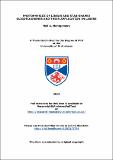Files in this item
Photophysics of linear and star-shaped oligofluorenes and their application in lasers
Item metadata
| dc.contributor.advisor | Samuel, Ifor D. W. | |
| dc.contributor.author | Montgomery, Neil A. | |
| dc.coverage.spatial | xii, 215 p. | en_US |
| dc.date.accessioned | 2013-06-19T15:42:10Z | |
| dc.date.available | 2013-06-19T15:42:10Z | |
| dc.date.issued | 2013-06-26 | |
| dc.identifier.uri | https://hdl.handle.net/10023/3734 | |
| dc.description.abstract | This thesis presents a study of the photophysical properties of a number of fluorene molecules used for organic semiconductor lasers. These results are then combined with lasing results to assess what the important properties in an organic semiconductor laser material are. Photophysical measurements were performed on a family of oligofluorenes; results show a redshift in the peak absorption and emission wavelengths with increasing length. There is also an increase in the molar extinction coefficient and photoluminescence quantum yields of the molecules. Transition dipole moments also increase with length, but fluorescence scales slower than absorption due to self-trapping occurring at longer molecular lengths. This study was then expanded to two families of star-shaped molecules with fluorene arms and differing cores. These molecules have three arms connected to either a central benzene unit or a larger truxene core. These molecules show an increase in PLQY and roughly three times higher molar extinction coefficients than comparable linear oligofluorenes. The star-shaped molecules PLQY and transition dipole moments are both greater than their linear oligofluorene counterparts. Energy transfer was then studied in the truxene-cored molecules, which showed that the symmetry of the molecule was broken due to interactions with the solvent. Energy transfer was observed on two timescales; a fast 500 fs process which is attributed to a localisation onto a single arm to emit, and a 3-10 ps second decay component, and was assigned to resonant energy transfer between the arms. Both decays were found to be wavelength dependent. Lasing results were then obtained for the benzene cored molecules. It was found that star-shaped molecules present improved lasing characteristics with lower ASE and lasing thresholds. These results were compared with those obtained for truxene-cored molecules whose rigid core provides them with better lasing and ASE characteristics. | en_US |
| dc.language.iso | en | en_US |
| dc.publisher | University of St Andrews | |
| dc.subject | Photophysics | en_US |
| dc.subject | Star-shaped | en_US |
| dc.subject | Laser | en_US |
| dc.subject | Fluorene | en_US |
| dc.subject | Truxene | en_US |
| dc.subject.lcc | TA1700.M76 | |
| dc.subject.lcsh | Semiconductor lasers--Materials | en_US |
| dc.subject.lcsh | Fluorene--Properties | en_US |
| dc.subject.lcsh | Oligomers--Properties | en_US |
| dc.title | Photophysics of linear and star-shaped oligofluorenes and their application in lasers | en_US |
| dc.type | Thesis | en_US |
| dc.type.qualificationlevel | Doctoral | en_US |
| dc.type.qualificationname | PhD Doctor of Philosophy | en_US |
| dc.publisher.institution | The University of St Andrews | en_US |
This item appears in the following Collection(s)
Items in the St Andrews Research Repository are protected by copyright, with all rights reserved, unless otherwise indicated.

